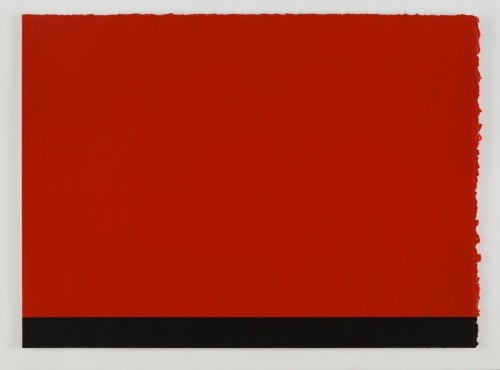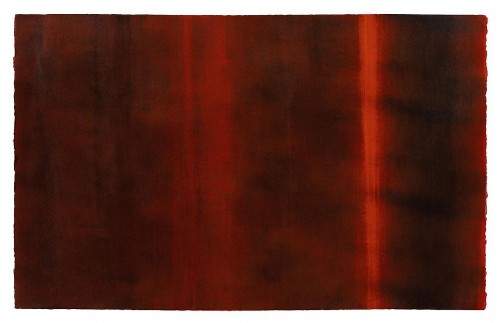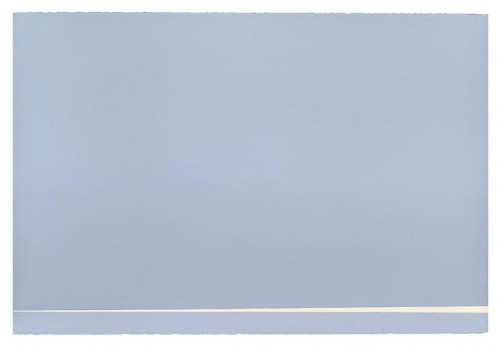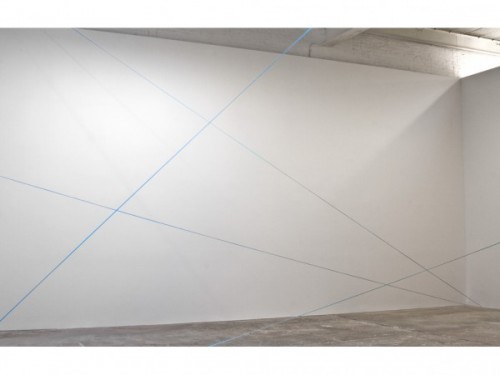
Anne Truitt, "Remember No. 5," 1999. Acrylic on paper, 22 x 30 inches. Copyright Estate of Anne Truitt / The Bridgeman Art Library. Courtesy Matthew Marks Gallery.
A recent visit to the art galleries in Chelsea offered me an opportunity to revel in the work of two of the more underappreciated artists that emerged from the 1960s: Fred Sandback and Anne Truitt. And while their respective places in art history are no doubt secure, Sandback and Truitt are still not quite household names. Their current solo exhibitions in New York remind us why they should be.
Matthew Marks Gallery’s exquisite retrospective of works on paper by Anne Truitt, who died in 2004, offers an opportunity to see the diversity of the artist’s vision, while also revealing that her work defies easy pigeonholing—seemingly a pre-requisite to attaining household-name status. Spanning four decades of her art and a range of media, the exhibition affirms why Truitt’s art has resisted simple categorization and concise definition despite her well-rehearsed relationship to Minimalism and Hard-Edge Abstraction. Partial explanation for this can perhaps be found in Truitt’s sustained commitment to infusing her art with reference and allusion while exhibiting a meticulous fluency with the lexicon and aesthetic of those art movements, movements that often downplayed those same qualities.
The associative power of Truitt’s minimal, reductive forms is evident in a set of early graphite drawings from the 1960s, wherein she distilled architectural elements of her childhood home to a few geometric shapes and repeating lines. Her subsequent inclusion of vibrant color and further reduction of compositional elements heralds the arrival of Truitt’s hard-edge style and evokes the painted wooden sculptures for which she is best known (one of which is on display in the gallery’s street level window). These and other early works that refuted gestural techniques would attract the attention and praise of, among others, Clement Greenberg, one of the foremost critics at the time and a dominant voice in the art world.

Anne Truitt. "9 Jan '73," 1973. Acrylic on paper, 25 1/2 x 40 1/2 inches. Copyright Estate of Anne Truitt / The Bridgeman Art Library. Courtesy Matthew Marks Gallery.
A series of acrylics also on view illuminates Truitt’s unexpected turn in the 1970s toward more subdued color combinations and less precise forms. The most exquisite is 9 Jan ’73, whose ethereal vertical bands floating in a monochromatic field of color reveal the enduring impact of her epiphanic encounter in 1961 with the work of Ad Reinhardt and Barnett Newman in H. H. Arnason’s seminal exhibition American Abstract Expressionists and Imagists at the Guggenheim Museum in New York.

Anne Truitt. "Summer '96," 1996. Acrylic on paper, 40 1/2 x 60 inches. Copyright Estate of Anne Truitt / The Bridgeman Art Library. Courtesy Matthew Marks Gallery.
As the Matthew Marks exhibition reveals, sharply delineated forms and contours return to powerful effect in the last decades of Truitt’s life. In Summer ’96 a single band of white across the work’s lower register interrupts an unmodulated expanse of pale-blue, reminiscent of a slender strip of sand dividing the boundless sky from a tranquil sea. It is a beautiful work, whose hypnotic sparseness might just as easily be in the service of evoking the sublime expanse and majesty of nature itself. Grounded in the close observation of nature yet transcending the particulars of time and place, Summer ’96 is a testament to Truitt’s life-long exploration of the interplay between meaning and form.
The Fred Sandback exhibition, Decades, at David Zwirner Gallery offers, as its title implies, a retrospective sampling of Sandback’s career-long investigation of sculpture and its surroundings. Including works from 1969 to 2000, the Zwirner exhibition also includes a spatial reconstruction of Galerie Heiner Friedrich, Munich, a gallery for which Sandback designed a number of situationally specific works in the 1960s and 1970s. Including works from every decade of Sandback’s career (he died in 2003), this exhibition offers a wonderful opportunity to appreciate the artist’s self-proclaimed goal to “assert a certain place or volume in its full materiality without occupying and obscuring it.”[1]
The current Zwirner exhibition traces Sandback’s progression from cord and wire to acrylic yarn—which by the 1970s becomes his primary material—to make understated yet dazzling sculptural works that engage their surroundings while also producing a dynamic perceptual experience. Slight and subtle, Sandback’s yarn pieces explore issues of sculptural mass and volume and the re-articulation of the space of exhibition, but are at their best in works such as Untitled (Vertical Two-part Corner Piece)(1968) and Untitled (Sculptural Study, Four-part Mikado Construction) (1991/2011).

Fred Sandback, "Untitled (Sculptural Study, Four-part Mikado Construction)," ca. 1991/2011. Aqua acrylic yarn. Dimensions variable. Courtesy David Zwirner Gallery.
In these two representative works from different ends of Sandback’s career, the viewing experience becomes a deeply phenomenological one, as our perception and understanding of the objects shift with each change in viewing position. In the later work, several taut strands of aqua acrylic yarn extend from floor to wall ceiling at different angles and directions, spanning the room and dividing space. As the viewer moves around and through the web of lines, the thin strands of yarn appear to emerge and recede against the white walls and dark floor, and each thin strand produces something like a parallax effect, whereby the eye struggles to focus in on the diaphanous strands of yarn, yet which registers as an apparent displacement and fluctuation of the objects themselves. Offering complex relations that engage the viewer’s perception of object and space, Sandback’s lean works vibrate with an intensity that belies their minimal construction and form.
Both the Truitt and the Sandback exhibition function as worthy reminders of the varied strains of art that emerged from the 1960s, and each offers a rare opportunity to view—or re-view—work that spans the influential careers of two important, if at times underappreciated artists from the second half of the twentieth century.
Fred Sandback: Decades is on view at David Zwirner Gallery, New York through April 21.
Anne Truitt: Drawings at Matthew Marks Gallery, New York, is on view through April 14 2012.
[1] Fred Sandback, “Remarks on My Sculpture 1966–1986,” in Fred Sandback Sculpture 1966–1986 (Mannheim: Kunsthalle, 1986), p. 12.



